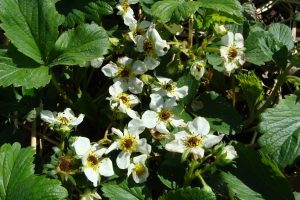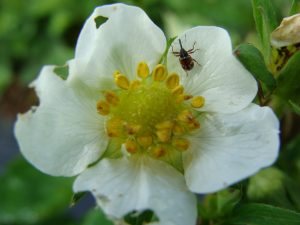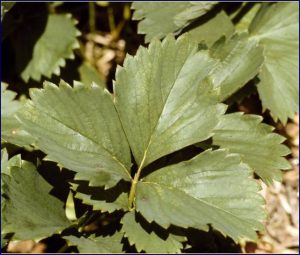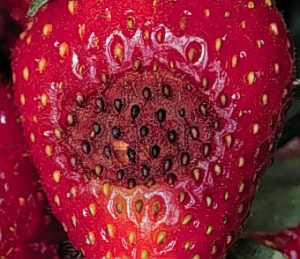Strawberry IPM Newsletter No. 2 – May 19, 2023
CHALLENGING FROST SEASON THREATENS CROP
Insect Pest Situation Very Quiet, Disease Pressure Increasing With Irrigation Events

Situation: A frost event this week hit many strawberry fields just as they were coming into bloom, which is the stage at which they are most sensitive to cold temperatures. Fortunately, there was plenty of warning about the event, and most growers were able to irrigate and/or use row covers to protect their plants. Damaged flowers will have brown or black centers, indicating that the receptacle, the part of the flower that becomes the strawberry, has been injured or killed, and therefore no fruit will form from those flowers. In the case where the primary or king blossom is killed, but the secondary flowers survive, there is often compensation; the secondary berries will grow larger and make up for the loss of the primary to some extent.
The insect and mite situation hasn’t changed much from last week, remaining very quiet. We are on the alert for disease problems, which may be encouraged by the irrigation water applied for frost protection.

Strawberry bud weevil: We have not yet seen any flower bud damage from “clippers”, but we have seen a few small holes in flower petals, indicating that the adults are present in some fields. Growers with fields in bloom should be on the lookout for clipped buds. The control threshold for clipper injury is more than 1.2 clipped buds per two feet of row. Once the buds have opened these insects no longer cause significant injury. At this point you should expect clipper damage to be most common in later blooming varieties.
Tarnished plant bug activity has not yet been observed in the strawberry fields we’ve scouted. Cool, wet weather may be holding down populations for the moment, but expect to see both adults and nymphs active in fields soon. It is important to scout for them regularly, as they may appear very quickly once the weather improves. The threshold for plant bug nymphs is 4 or more flower clusters infested per 30 sampled. Tap flower clusters over a plate or tray to knock any nymphs off. If any appear on the plate after tapping, count that cluster as “infested”.
White grubs: I have found white grubs in a couple of fields this week that were showing weak, stunted growth. These grubs are likely the larvae of Japanese beetle, European chafer and/or Asiatic garden beetle. Their feeding weakens the plants by reducing the number of roots. The grubs can be found by pulling up weak plants and sifting through the soil that surrounds the roots. These tend to be more of a problem in new fields that have been planted following a grass rotation crop. Admire Pro® insecticide is labeled for control of white grubs and should be applied within two hours of irrigation or rainfall to be sure the chemical gets into the root zone. Admire Pro® requires a 14 day to harvest interval.
Two-spotted spider mites: We found spider mites in fields at two locations this week, but in both cases the populations were not over the recommended control threshold. Start scouting for mites now, if you haven’t already. To scout for mites, collect 60 leaves from various locations in the field and examine the undersides for the presence of mites. If more than 15 leaves out of 60 sampled have any mites (25% infestation) a control should be applied. Chemical control options for two-spotted spider mites include Acramite®, Portal®, Savey®, Zeal®, Oberon®, Danitol® and JMS Stylet Oil® (oils will cause plant injury if used in combination with captan or within 14 days of an application of sulfur).

Cyclamen mites: I have seen limited examples of cyclamen mite injury in fields this week, but no large infestations. Infested plants show weak growth and shrunken, crinkled leaves. These mites are very small and reside in the crown of the strawberry plant, feeding on the developing leaves and flower buds. They are very hard to see, even with magnification. Portal® miticide can be effective, but must be applied in lots of water to be sure that the material is carried down into the crowns where these mites reside.
Diseases: Bloom is a critical time to protect strawberry fruit against gray mold caused by the fungus Botrytis cinerea, especially when conditions have been damp. Two to three sprays of fungicide during bloom are typically required to provide good protection against this disease. Applying irrigation for frost control can create a good environment for Botrytis development. Be sure to use an appropriate fungicide shortly after any significant irrigation event during the bloom period.
Angular leaf spot: I have seen more angular leaf spot in strawberries this week, and expect infections could become more widespread as a result of irrigation being applied for frost control. Symptoms of this bacterial disease include translucent spots between the veins on the leaves that turn yellow and eventually black. Symptoms start on the lower leaves and move upwards as spores are splashed up by rain or irrigation water. Infection of the calyxes causes blackening of the berry stems and caps. Frequent irrigation for frost protection encourages the spread of this disease. Kocide® (copper), can reduce the spread of this disease but spray applications must be applied before bloom. Application of copper sprays after bloom can result in fruit injury. Hydrogen dioxide (OxiDate®) may have some activity against angular leaf spot when used on strawberries as part of a gray mold management program.
Leather rot (Phytopthora cactorum) can become a problem in fields where standing water is common during bloom and fruit development, especially if the fields were not mulched last fall. Incidence of leather rot can be reduced by applying straw mulch between the rows to prevent berries from touching the soil and reducing soil splashing onto the berries. Foliar sprays of Aliette®, Prophyt® or Phostrol® may be applied during bloom and fruit development to prevent leather rot.

Anthracnose fruit rot: As fruit ripens in fields that are wet from irrigation or rainfall, be on the lookout for anthracnose. This disease is favored by warm, humid conditions and can spread rapidly via splashing water during rain or irrigation events, especially if puddles remain in a field. Anthracnose appears as black sunken lesions on the berries with orange spore masses in them. The fungus can multiply on leaves without visible symptoms, which is why it may appear suddenly and widespread in a field. Recommended fungicides include Pristine®, Cabrio® and Abound®.
Spring Growers’ Twilight Meeting
The Maine Vegetable & Small Fruit Growers Association will be having a Spring Twilight Meeting on Tuesday, June 6, at 5:30 pm at Stevenson’s Strawberries, 271 Tucker Road in Wayne. The Stevenson’s specialize in strawberries but also grow a wide variety of vegetables for their stand and CSA.
The latest edition of the 2022-2023 New England Small Fruit Management Guides.
Sincerely,
David T. Handley
Vegetable & Small Fruit Specialist
Highmoor Farm Pest Management Unit
P.O. Box 179 17 Godfrey Dr.
Monmouth, ME 04259 Orono, ME 04473
207.933.2100 1.800.287.0279
Where brand names or company names are used, it is for the reader’s information. No endorsement is implied nor is any discrimination intended against products with similar ingredients. Always consult product labels for rates, application instructions and safety precautions. Users of these producers assume all associated risks.
The University of Maine is an equal opportunity/affirmative action institution.
